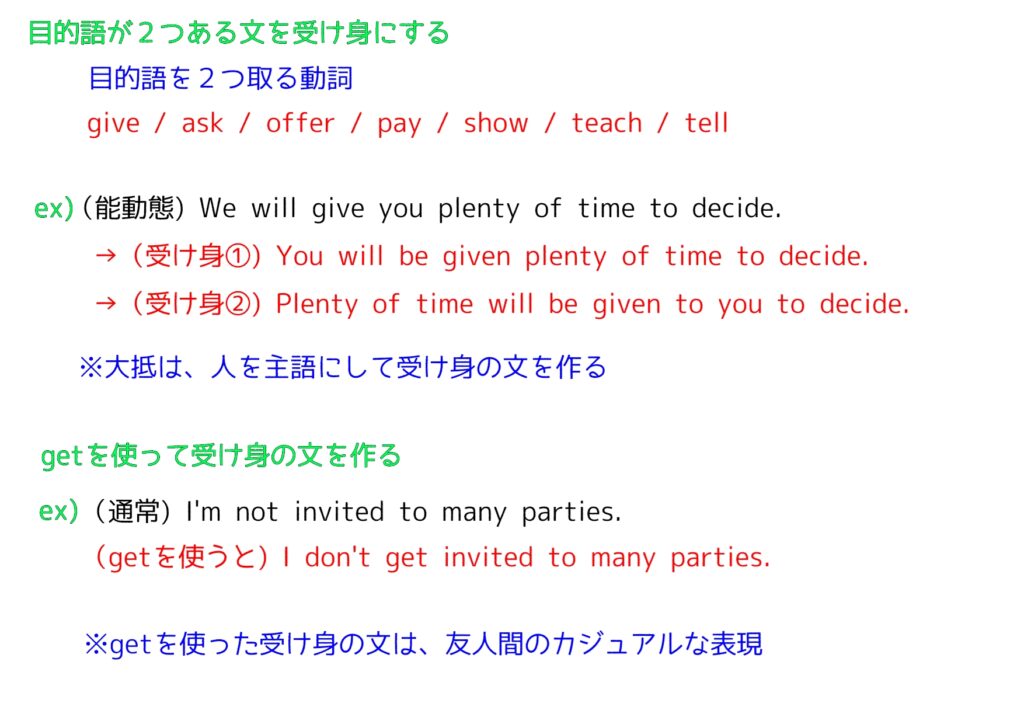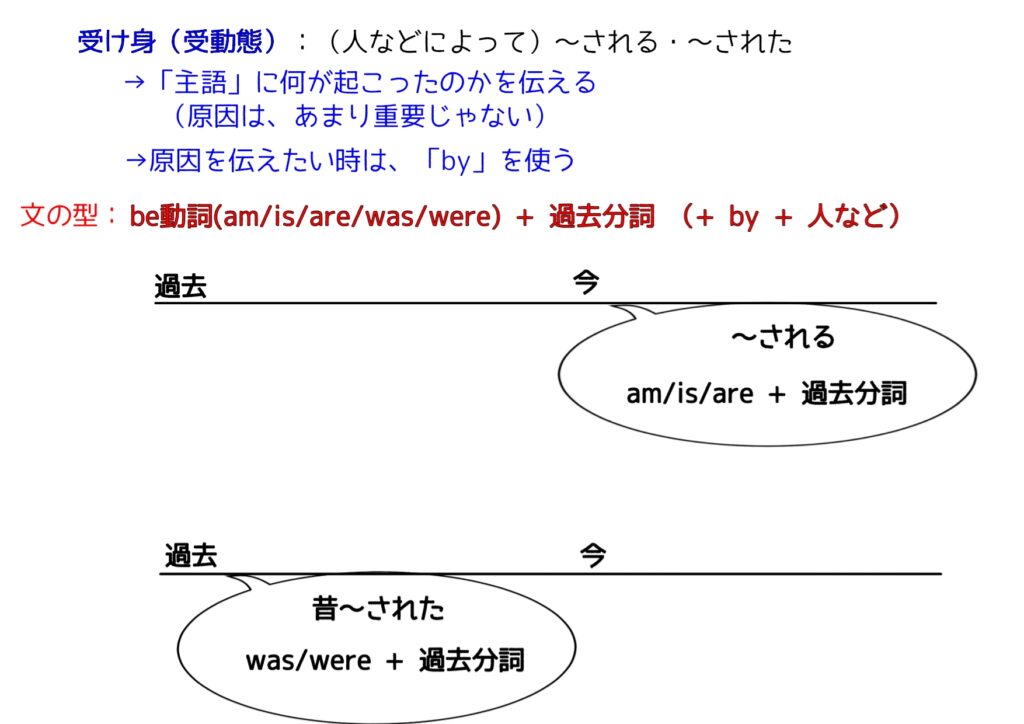第22回:受動態(受け身)の文の様々な形。

様々な受動態の文の形や、熟語を使った受動態の文の作り方を確認します。
Q. この記事で、一番大事なことって何?
A. 大事なことを、1枚の画像にまとめました。

いちいちノートにまとめるのが面倒だという方、また、
ノートにまとめることが苦手だという方は、ご活用ください。

[広告]
確かな英語力は、日々の継続から。
その継続を後押しする、第二言語習得理論に基づいた
オンライン英語学習プログラムがあります。
英語を使う人のための、確実なスキルアップが望める
7日間の無料体験はこちらから!

Q. 受動態の文の基本的な作り方は?
A. 以下に作り方の手順を記します。
Step 1: 受動態にする動詞を選ぶ
受動態にするには、目的語が主語になり、動詞は過去分詞形に変わります。例えば、「The dog chased the cat」を受動態にする場合、「chased」は過去分詞形に変え、「The cat was chased by the dog」となります。
Step 2: 受動態の主語を決める
受動態の主語は、元の文の目的語がなります。例えば、「The dog chased the cat」の受動態は、「The cat」が主語となります。「The cat was chased by the dog」。
Step 3: be動詞を選ぶ
be動詞は、受動態を作るために必要な動詞です。be動詞は文脈に応じて、am、is、are、was、were、been、beingのいずれかを選びます。例えば、「The cat was chased by the dog」のbe動詞は「was」です。
Step 4: 動詞の過去分詞形を選ぶ
be動詞に続く動詞は、元の文の動詞の過去分詞形になります。例えば、「The cat was chased by the dog」の動詞「chased」は、過去分詞形になっています。

受動態の様々な形、とは?
英語における受動態の形成について詳しく解説します。
① 「give、take、award、hand、lend、offer、send、throw」などの動詞は、間接目的語(IO)と直接目的語(DO)を取ることができます。これらの動詞には、「V+I0+DO」または「V+DO+前置詞+I0」の2つの受動態形式があります。また、「ask、read、teach」などの動詞は、間接目的語を取らず、「V+DO+前置詞+I0」の受動態形式しか持ちません。
例えば、「Alice gave us that vase」という文では、「V+I0+DO」の形式が使われています。この文を受動態にする場合、「We were given that vase (by Alice)」とすることができます。また、「Alice gave that vase to us」という文では、「V+DO+前置詞+I0」の形式が使われています。この文を受動態にする場合、「That vase was given (to) us (by Alice)」とすることができます。受動態を使うかどうかは、文脈によって異なります。また、特定の動作主を明示する場合は、文の最後に動作主を置く必要があります。
② 「announce、demonstrate、describe、introduce、mention、propose、report、suggest」などの動詞は、間接目的語を取らず、「V+DO+前置詞+I0」の形式の受動態しか持ちません。また、「目的語 + 補語」の形式を持つ動詞としては、「elect、appoint、declare、make、nominate、vote、call、name、title」などがあります。
③ 「目的語 + 動詞の原形」の形式を持つ動詞(=原形不定詞を取る動詞)には、「feel、hear、help、observe、see」などがあります。これらの動詞の受動態では、不定詞が使われます。
④ 2〜3語の群動詞には、受動態形式があるものもあります。例えば、「look after、carry out、disapprove of、hold over、talk down to」などです。一方、「brush up on、cast (your mind) back、get (something) down、take after」などは、受動態を持たない動詞として挙げられます。
⑤ 一部の動詞は特定の意味でのみ受動態を持ちます。例えば、put outは「火を消す」という意味では受動態形式がありますが、「手を出す」という意味では受動態を持ちません。
具体例
Verbs with both DO and IO:
- Active: The teacher gave the students a test.
- Passive 1: The students were given a test (by the teacher).
- Passive 2: A test was given to the students (by the teacher).
- Active: The company offered me a job.
- Passive 1: I was offered a job (by the company).
- Passive 2: A job was offered to me (by the company).
Verbs with DO + preposition + IO:
- Active: She lent her car to him for the weekend.
- Passive 1: Her car was lent to him for the weekend (by her).
- Passive 2: He was lent her car for the weekend (by her).
- Active: The waiter handed the menu to us.
- Passive 1: The menu was handed to us (by the waiter).
- Passive 2: We were handed the menu (by the waiter).
Verbs with object + complement:
- Active: They named her CEO of the company.
- Passive: She was named CEO of the company.
- Active: The committee appointed him chairman.
- Passive: He was appointed chairman by the committee.
Verbs followed by object + bare infinitive in active, but to-infinitive in passive:
- Active: The coach made the team run laps.
- Passive: The team was made to run laps (by the coach).
- Active: The teacher helped the students to study for the test.
- Passive: The students were helped to study for the test (by the teacher).
Transitive two- and three-word verbs:
- Active: I talked down to my little sister.
- Passive: My little sister was talked down to (by me).
- Active: The firefighters put out the fire.
- Passive: The fire was put out (by the firefighters).
[広告]
TOEICのスコアを上げたいけれど、
まとまった勉強時間が取れなくて困っている…
なら、細かいスキマの時間を使いながら、
少しずつスキルを積み重ねてみてはどうでしょう。
スマホ1つでスコアアップが出来る、
オンライン講座のリンクはこちらから。

Q. この文法はどうやって使うのでしょうか?
A. 今回の文法を活用した会話文を見てみましょう。

Who was the vase given to?
(その花瓶は誰からもらったの?)

It was given to us by Alice.
(アリスがくれたの。)

That’s nice of her. Did she give any reason for giving it to you?
(優しいね。何か理由があったの?)

No, she didn’t mention anything. She just said she thought we would like it.
(ううん、何も。ただ、私たちが気に入ると思ったからと言って渡してくれたの。)

I see. Well, it’s a beautiful vase. I’m sure you’ll enjoy it.
(そっか。それにしても、美しい花瓶だね。きっと良い飾りになるね。)
[広告]
ロゼッタストーン・ラーニングセンターで、最先端の教育制度を活用して英語を学びませんか?私たちは個々の学習ペースに合わせてeラーニングと対面教育を組み合わせ、柔軟な学習環境を提供しています。自宅でのeラーニングと対面教育のメリットを最大限に活かし、あなたの英語学習をサポートします。最新のテクノロジーと個別の指導が組み合わさった当センターで、自由な学習スタイルを体験してみませんか?英語学習を楽しく効果的に進めるための環境がここにあります。新たな一歩を踏み出して、新しい英語学習の旅に参加しましょう!

Q. この記事の要点は?
A. 受動態の文の作り方について確認しました。
英語の受動態を作る際には、動詞の種類によって使い分けが必要です。例えば、giveやtakeなどの動詞は間接目的語(IO)と直接目的語(DO)を必要とするため、V+IO+DOまたはV+DO+前置詞+IOの2つの受動態形があります。また、報告動詞や任命動詞などには、1つの受動態形しかありません。動詞によっては、受動態の形がないものもあります。受動態を作るときには、文章の文脈に合わせて、どちらの受動態形を選ぶかを決定する必要があります。
英会話を始めてみたいけれど、どのサービスが良いか分からない…
そんな方は、まず、この記事で3つのサービスを比べてみてはいかがでしょうか?
英語力を効率良く伸ばすことができるサービス3選です。

次回の文法解説は?
この記事を作る際に参考にした文法の解説書になります。
すべて英語で書かれていますが、練習問題が付いてます。
イギリス英語なので、スペル等の表記が異なる部分もありますが、
「使い方を練習したい」「繰り返し問題を解きたい」
という方は、使ってみても良いかもしれません。

関連記事一覧
他の文法解説記事を検索できます。







-320x180.jpg)





コメント